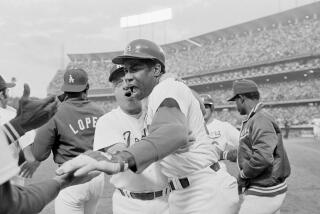Still Elegant After All These Years : Koufax Remains a Private Man and Pitching Legend
VERO BEACH, Fla. â For one brief, shining moment, it appeared to be another era, say 1959.
Off in a corner at Dodgertown, standing together behind a pitcherâs mound and wearing Dodger uniforms, were Sandy Koufax, Johnny Podres and Larry Sherry.
Podres and Sherry, the stars of the 1955 and 1959 world championship Dodger teams, respectively, and Koufax, the clubâs most famous pitcher, are part-time instructors today. They teach young pitchers in the winter instructional leagues, here during spring training and at such Dodger farms as those at Albuquerque, San Antonio, Bakersfield and Great Falls, Mont., during the season.
Old pitchers never seem to retire, they become coaches. One is still startled, however, to see the elegant Sandy Koufax doing such menial labor. Would Jack Nicklaus give golf lessons? Horowitz teach piano? Astaire coach young dancers?
A bright, quiet fellow who has always been reluctant to let anyone intrude upon his privacy, Koufax is hounded wherever he goes in this sprawling camp by fans who seek his autograph or beg him to pose for pictures. Many women put an arm around him while their husbands take their picture.
All this fuss over him does not seem to disturb Koufax outwardly, but it is not his style. He doesnât flinch or frown, but neither does he smile much.
Koufax, in fact, seems to be the most popular fellow in camp, with the exception of Manager Tom Lasorda. Many of the fans who seek his autograph were not even born when Koufax retired at the peak of his career in 1966. Even most of the sportswriters covering the team are not old enough to remember how good he was.
At 50, Koufax still looks as if he could pitch nine innings--and win. His hair is gray, but he is tan, lean and as fit as most of the young athletes he is coaching. In jeans, sweater and sneakers, he looks about 35.
When Koufax pitches batting practice, a crowd gathers. He commands the awe and respect of all the players, especially the young pitchers he coaches.
Arms folded, he watched a young left-hander throw for 15 or 20 minutes the other day. Occasionally and quietly he offered encouragement and advice, sometimes correcting the young manâs motion.
The pitcher, Gary Legumina, was 3 years old when Koufax suddenly quit the game. âIâve always heard about him,â Legumina said after the workout. âI think heâs great, and itâs amazing to see him throw so well now in batting practice.â
Last year at an instructional camp in Arizona, Legumina said, Koufax âmade a little adjustment in my footwork that has enabled me to keep my fastball down.â
Pitching coach Ron Perranoski said: â(The young pitchers) all look up to him. Heâs a legend.â
This is the eighth spring Koufax has been to Dodgertown after virtually disappearing for half a dozen years. He comes back each February, knowing that he must endure the stares of the fans, the whispered, âOh, I know who he is!â the autographs and pictures and the interviews. Even today he does not relish talking about himself.
âThis has all been written before,â he said when he was asked for an update on his life. But The Times last published a major story about Koufax in 1979, the first season he returned to baseball as an instructor.
Little has changed in his life since that story appeared. He moved south from Templeton, Calif., a small town near Paso Robles, to Santa Barbara about 18 months ago. He doesnât play golf as often as he used to but heâs traveling more, both foreign and domestic. âI canât tell you all the things I do,â he said.
Taking up jogging seriously a few years ago, he ran himself into a skinny, 162-pound weakling. He weighed about 45 pounds less than his playing weight. He stopped running a few years ago because of knee surgery. Today, he weighs 190 and, he said, he expects to start running again while heâs here this month.
He returned to baseball after living virtually in seclusion in small towns in Maine and Central California. âI needed a job,â he said.
He remains in the game for a second reason, however. âI enjoy working with the kids,â he said. âItâs fun.â
Eight years ago he had said, âIt was hard to stay away from the one thing I had done well in my life.â And, âIt became tough to make ends meet, the way the economy has gone. This job allows me to earn a living while continuing to live the way I choose. The desire to lead a private life hasnât left me.â
Can it really be 20 years since Sandy Koufax, the most celebrated pitcher of his time, walked away from the game in which he had excelled, giving up an enormous salary that today wouldnât buy a utility infielder?
Baseball was shocked. After all, Koufax was only 30 and had just won his third Cy Young Award with a record of 27-9 and an earned-run average of 1.73. For those impressive numbers he was paid the princely sum of about $135,000, a salary he received only after holding out that spring in tandem with Don Drysdale.
Reportedly, the pitchers had asked for $200,000 apiece, a sum that probably shocked Dodger owner Walter OâMalley as much as Koufaxâs retirement.
Koufax did not, however, quit over money. He had been pitching in pain, the result of an arthritic elbow and circulatory problems in his left arm, the one with which he compiled an ERA of 2.76; pitched four no-hit games, including a perfect one; led the National League in strikeouts four times, and three times won more than 25 games in 12 years. He won 129 games and lost only 47 in his last five seasons.
The arm still hurts sometimes, he said. âIt depends on what Iâm doing. It happens to every pitcher; it comes with the job.â
Early in his career, Koufax struggled with his control. He beat the problem and improved markedly as a pitcher, he said, when he matured as a person.
He stopped pressing and learned to control himself. Instead of trying to do everything 100%, he held back a little, maybe about 5%. The result was some remarkable statistics that put him into the Hall of Fame on the first ballot.
After he quit pitching, Koufax signed a 10-year contract with NBC as a commentator. A shy, sensitive fellow, he was not suited for the job and quit after six years. âIt was a hell of a job, but if you go to the ballpark every day hoping itâs going to rain, itâs obvious youâre in the wrong line of work,â he once said.
There isnât much difference in the way baseball is played today than when he played, Koufax said. âArtificial surfaces, the designated hitter and bigger contracts are about the only differences.
âYou always heard that you should keep the ball down, but today you can get away with not keeping it down in parks with artificial surfaces.â
Koufax doesnât refuse interviews as much as he politely resists them. He just doesnât like to talk about himself or have anyone pry into his private life. Told that fans still wish to read about him, he said, âI appreciate their interest.â
He resents the charge that he went into hiding. âI am not a hermit,â he said. âIâm not hiding. If you move out of Los Angeles, people think you are a freak.â
President Peter OâMalley said once that he would pay Koufax today as much âas it was necessary to keep him. This is one man who would be worth every penny.â
But when asked to speculate on his worth today, Koufax replied: âIâd get the going rate. Theyâd pay me what everyone else is getting.â
The truth is, probably, that considering what the going rate is today, no team could afford a fellow with the marvelous skills of Sandy Koufax.
More to Read
Go beyond the scoreboard
Get the latest on L.A.'s teams in the daily Sports Report newsletter.
You may occasionally receive promotional content from the Los Angeles Times.










